2.1 Pitch, Clefs, and Intervals: Tutorial
Pitch
Pitch is the highness or lowness of a sound. Just like we have a language alphabet, we also have a musical alphabet. We use A-B-C-D-E-F-G to name pitches. We repeat these pitches up and down in a loop as we get higher or lower on a staff: A-B-C-D-E-F-G-A-B-C-D-E-F-G-A.
Staff
A staff is made up of 5 lines and 4 spaces. We count lines and spaces from the bottom up when naming the specific line or space a note is on.

Clefs
Clefs are symbols used at the beginning of a staff that specific what notes fall on each line and space. The four clefs commonly used are treble clef, bass clef, alto clef and tenor clef.
The treble clef is also called the G clef. The treble clef symbol evolved from writing the letter G in script on a staff. It is drawn so that it curves around the second line on the staff, symbolizing that the second line is the pitch G. From that reference pitch, we can count up and down each line and space on the staff using the musical alphabet in order to find the rest of the pitches used in treble clef. To help memorize the notes in treble clef, it’s helpful to separate notes into those found on lines, and those found on spaces when using mnemonic devices to memorize pitches.

The treble clef is used for high-pitched instruments like the flute, oboe, clarinet, violin, and soprano and alto voices.
The bass clef evolved from writing the letter F in script on a staff. It is drawn so that the dots surround the fourth line on the staff, symbolizing that the fourth line is the pitch F. For this reason, the bass clef is also known as the F clef. As with the treble clef, we can use the reference pitch F to find all other pitches on the staff in bass clef.

The bass clef is used for lower-pitched instruments like the trombone, bassoon, cello, and tenor and bass voices.
The alto clef, also called the C clef, evolved from drawing a C on the staff around line 3. The symbol we use today looks like two backwards Cs that meet on the third line, symbolizing that the third line on the staff is the pitch C. You can memorize the lines and spaces on the alto clef staff, and can also think of reading the notes in treble clef and transposing each note down a step. The alto clef is primarily used for the viola.

Like the alto clef, the tenor clef is also a C clef, but the C is drawn on the staff on the fourth line. Today, we use the same symbol for alto clef and tenor clef, but the placement of the clef changes. While the alto clef is placed on the third line, the tenor clef on the fourth line. In tenor clef, the fourth line on the staff is the pitch C. You can memorize the lines and spaces on the tenor clef staff, and can also read the notes as if they were in treble clef and transpose each note up a step. The tenor clef is used for bassoon, cello and trombone with the pitches are too high to easily read in bass clef.

This is what middle C looks like in each clef:

Ledger Lines
Ledger lines are small lines used to extend the length of the staff vertically so that notes higher and lower than the staff can be used. Using a ledger line allows you to continue to count lines and spaces in order to use the musical alphabet. Ledger lines can be used in any clef, but are only used when needed.

The Keyboard
A keyboard is made up of a repeating set of white and black keys. The white keys correspond to the notes of the musical alphabet. The black keys are separated into groups of two back keys and groups of three black keys. Notice that C is always the white key directly to the left of the group of 2 black keys.

The Grand Staff and the Keyboard
A grand staff combines the treble and bass clefs. It is drawn with a treble clef staff on top and a bass clef staff below. The staves are joined by bar lines that goes through both staves as well as a brace.

Music for piano typically uses the grand staff. All of the pitches on the keyboard have a corresponding note on the grand staff. Middle C joins the treble clef and bass clef staves using a ledger line.
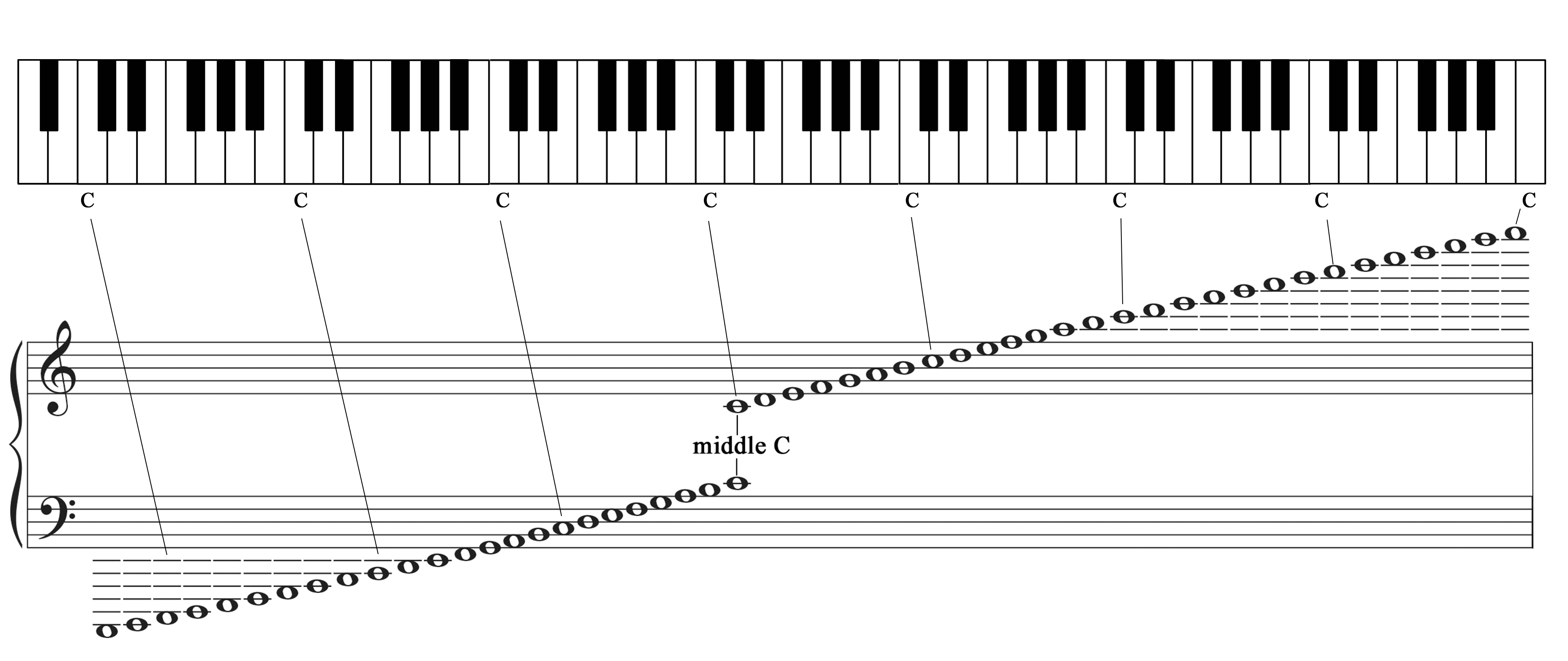
Octaves and Octave Designation Numbers
When counting up or down the musical alphabet, the point at which you repeat a pitch name it called an octave. The term octave comes from the Greek work okta, meaning 8. Octaves are notes that share the same letter name and are 8 letter names apart. We describe any note that is identified by its letter name but not by a specific position in a particular octave as part of a pitch class. For example, any E, regardless of where it occurs on a staff, is part of the pitch class E. When talking about music, we often need to refer to a specific note in a specific octave. We use octave designation numbers in order to name specific pitches on the keyboard and staff. There are eight Cs on a keyboard, each labeled with a number from 1 to 8. Each pitch within the same octave is labeled with the same number. The chart below shows the octave designations for each specific pitch on the keyboard and grand staff.
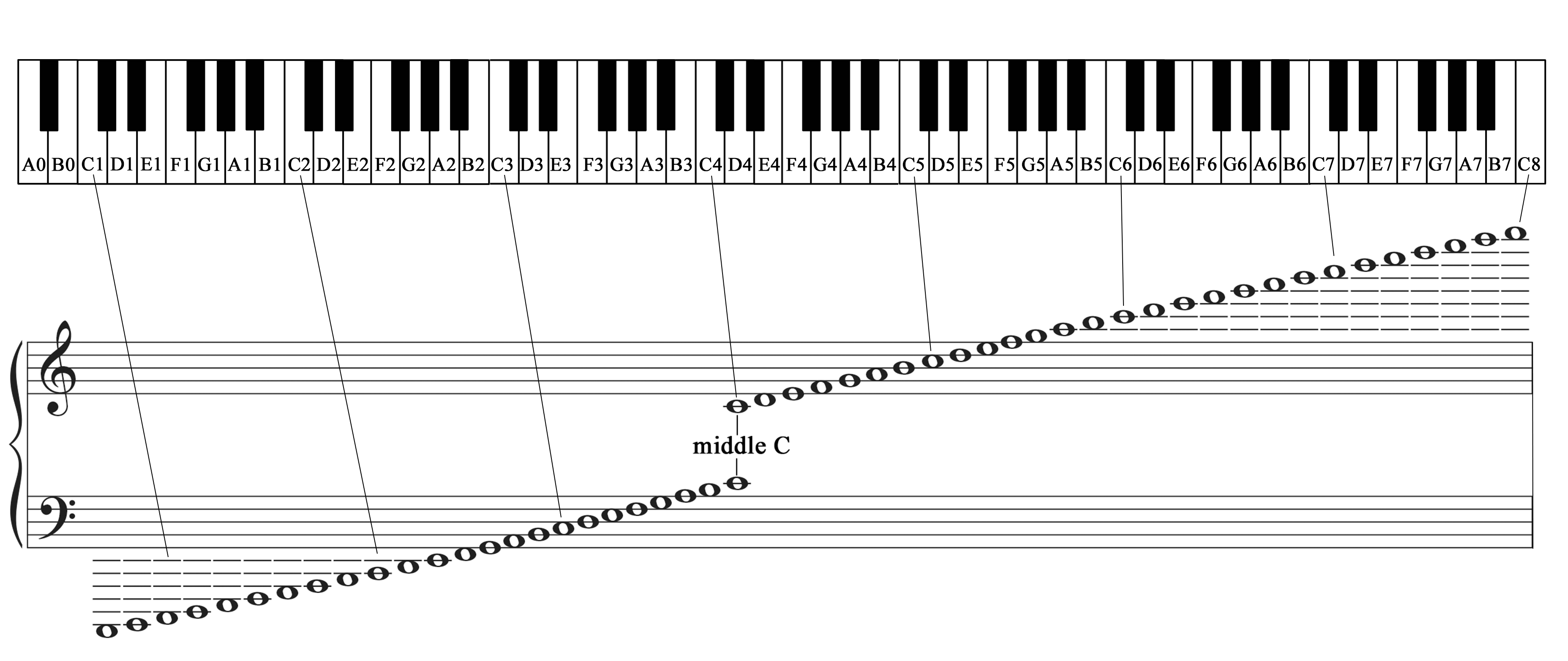
Half Steps
An interval in music measures the distance between two pitches. A half step, also called a semitone, is the distance between any pitch and the next closest pitch in either direction. On the keyboard, half steps most often occur between white keys and black keys.
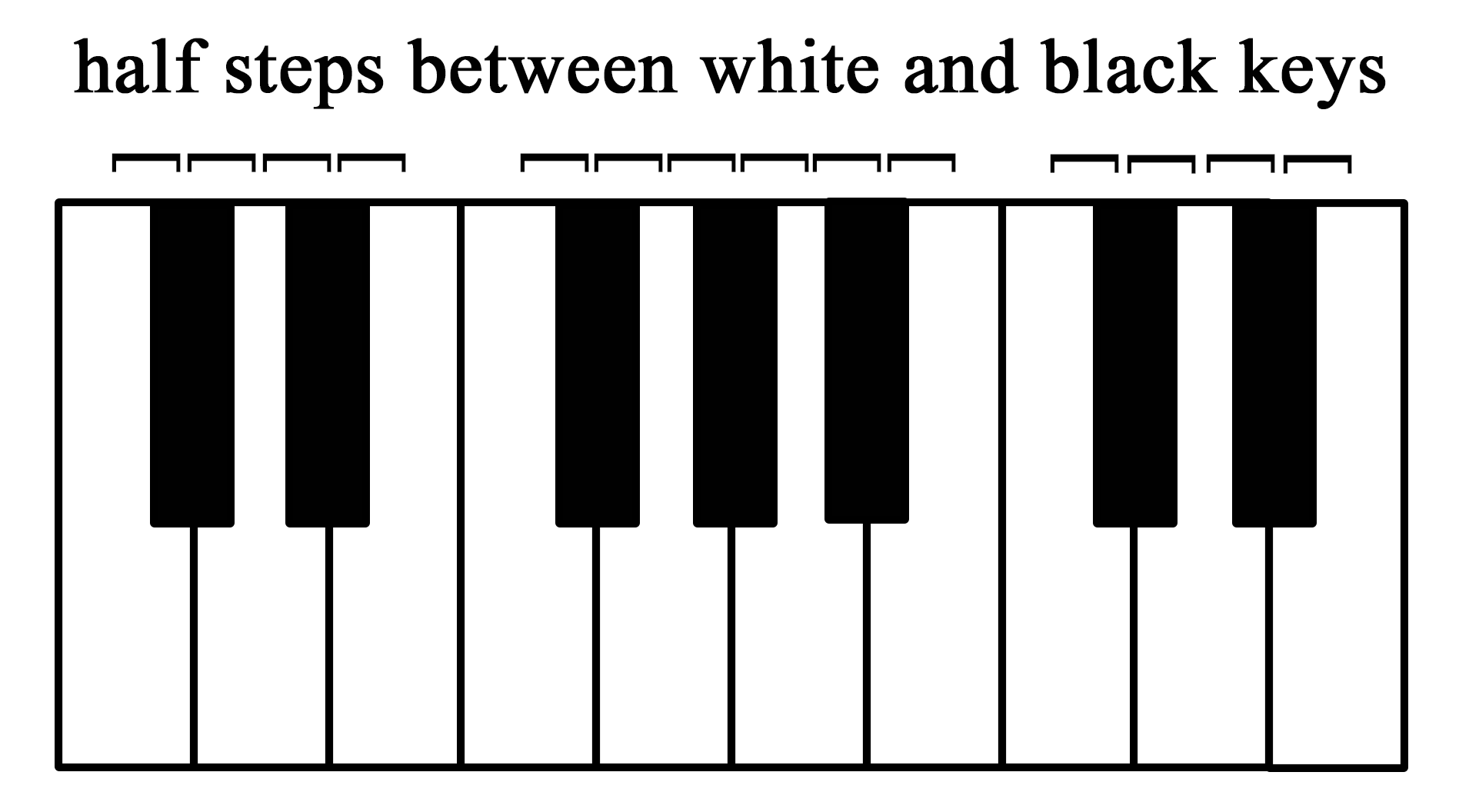
There are two instances on the keyboard where there is no black key between two white keys. In this case, the space between the two white keys is a half step. That means B to C and E to F are half steps.
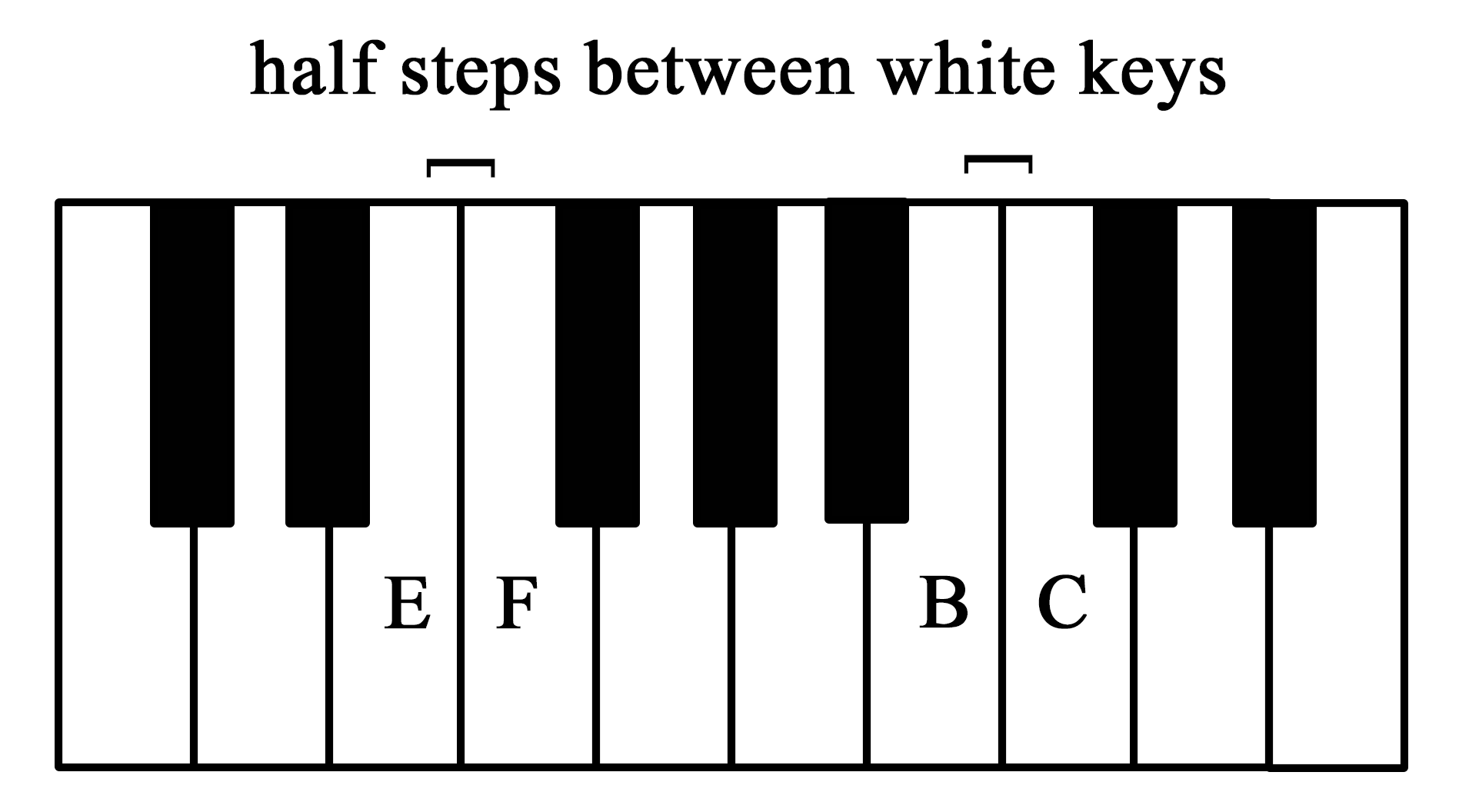
In order to name the black keys on the keyboard, we need to understand accidentals in music.
Accidentals
Accidentals in music are symbols that raise or lower a note in the musical alphabet while keeping the basic letter name of the note the same. Accidentals are written directly to the left of a note on the same line or space that the note is on.
Sharps raise a note by a half step.
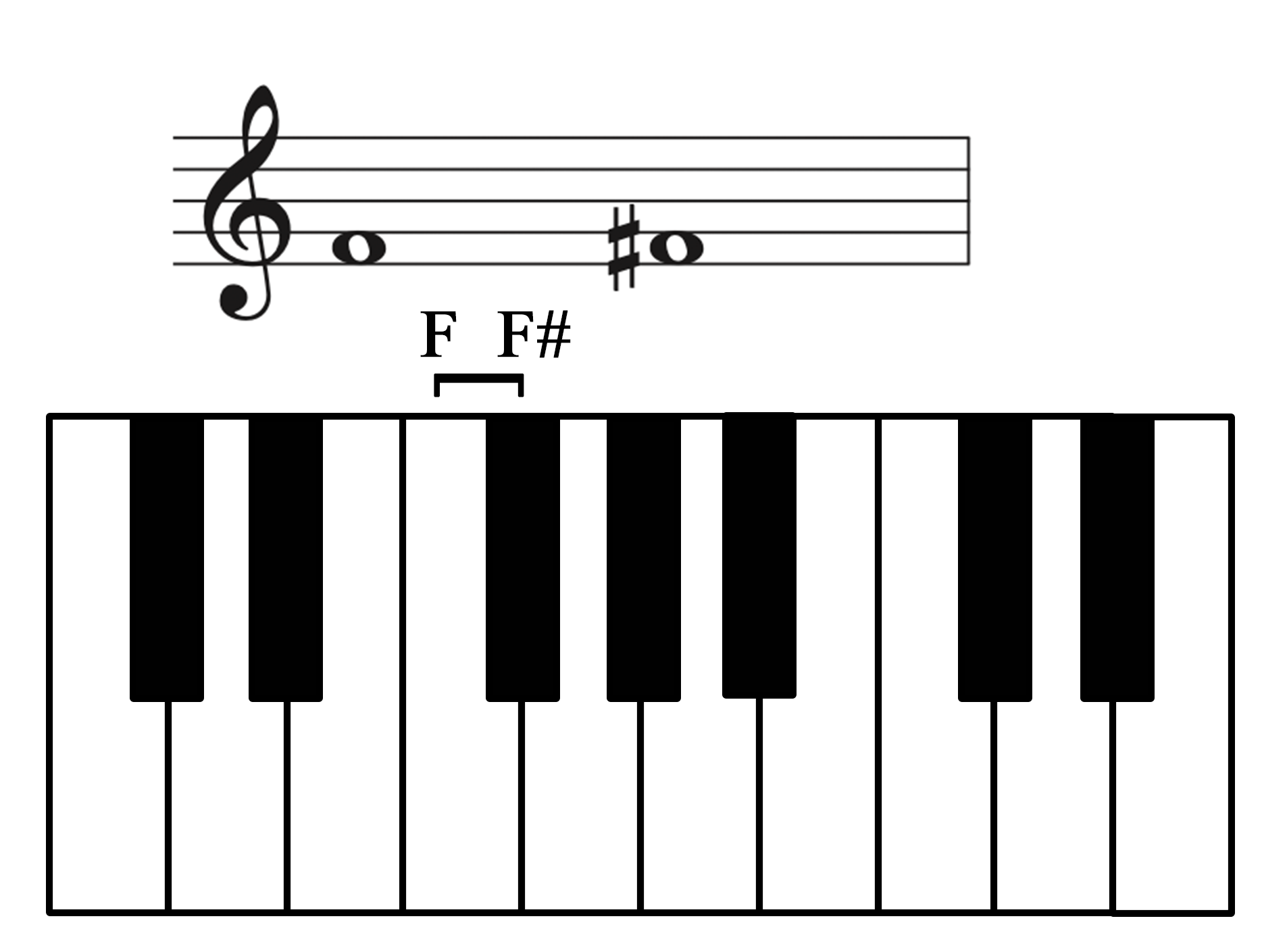
Flats lower a note by a half step.
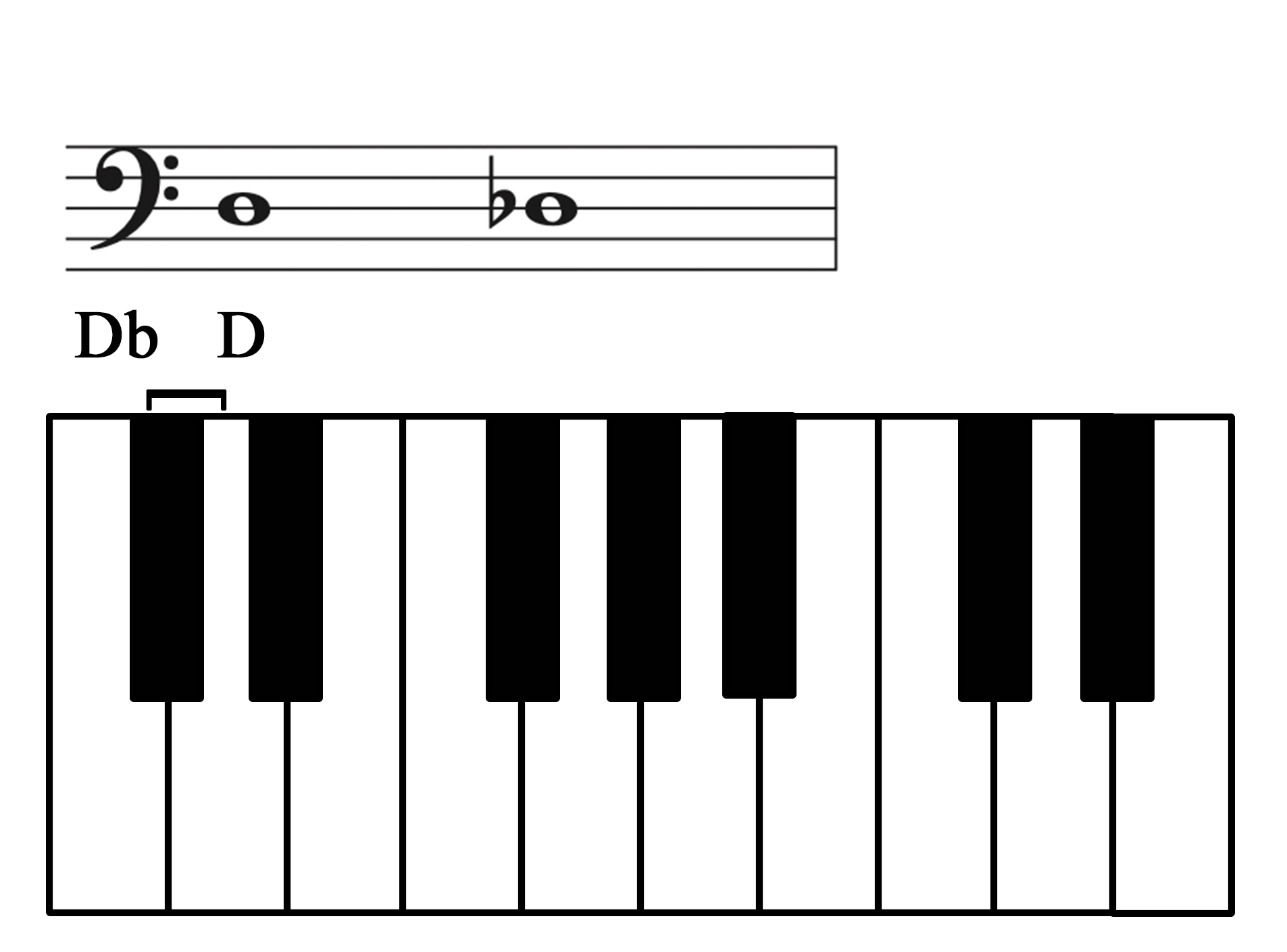
Natural signs cancel out a previous accidental.

Double sharps raise a note by two half steps.
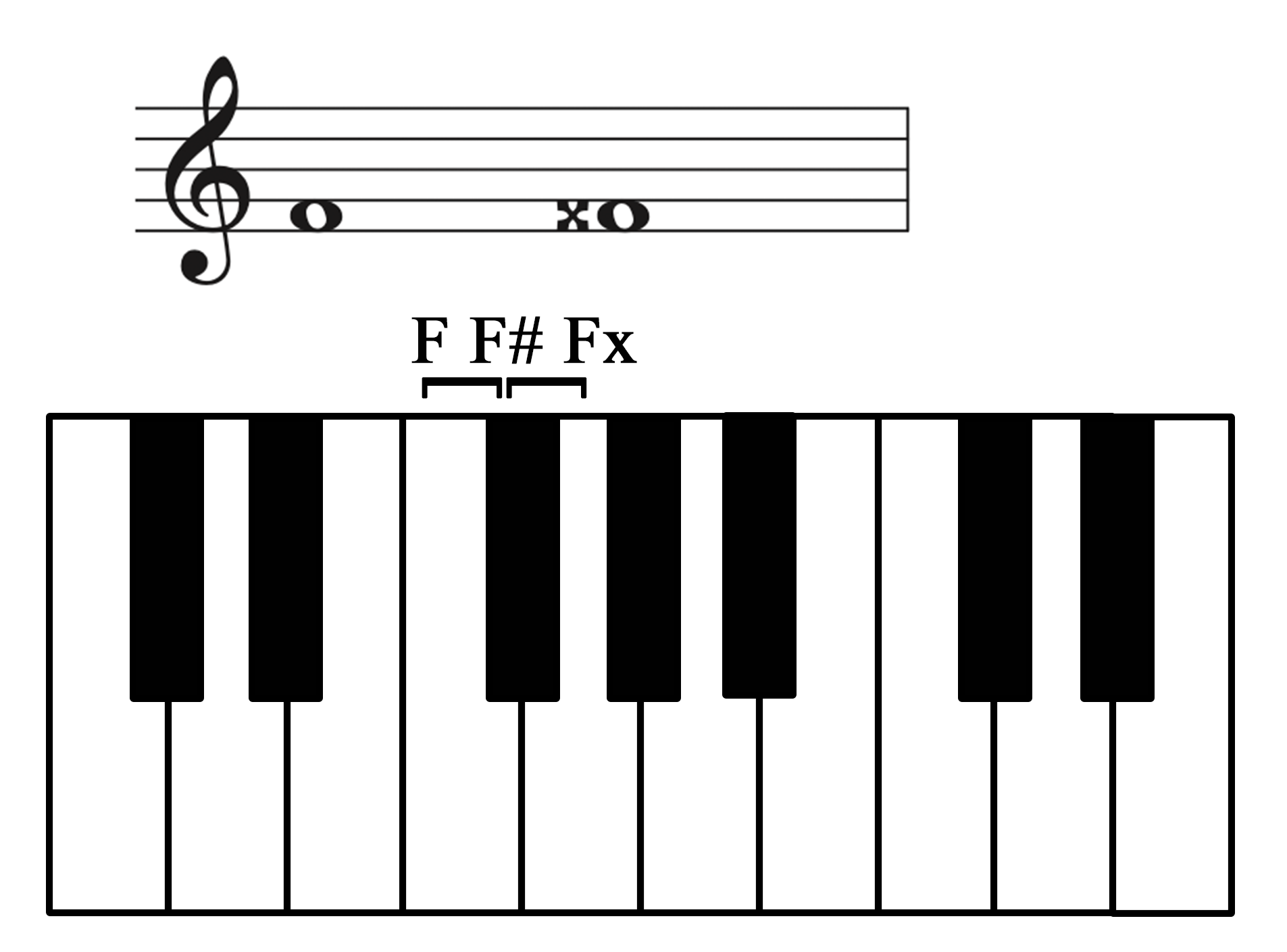
Double flats lower a note by two half steps.

Once introduced into a measure, accidentals will carry through the whole measure unless cancelled with another accidental. However, accidentals do not carry through octaves, so need to be added to notes that are an octave higher or lower than a previous accidental.
Enharmonic pitches
Enharmonic pitches are notes that sound the same, but are spelled differently. On the keyboard, the black keys in between each white key can be named in two ways. For example, the black key between C and D could be called C# or Db. C# and Db are enharmonically equivalent. They sound the same, but are written differently on the staff.
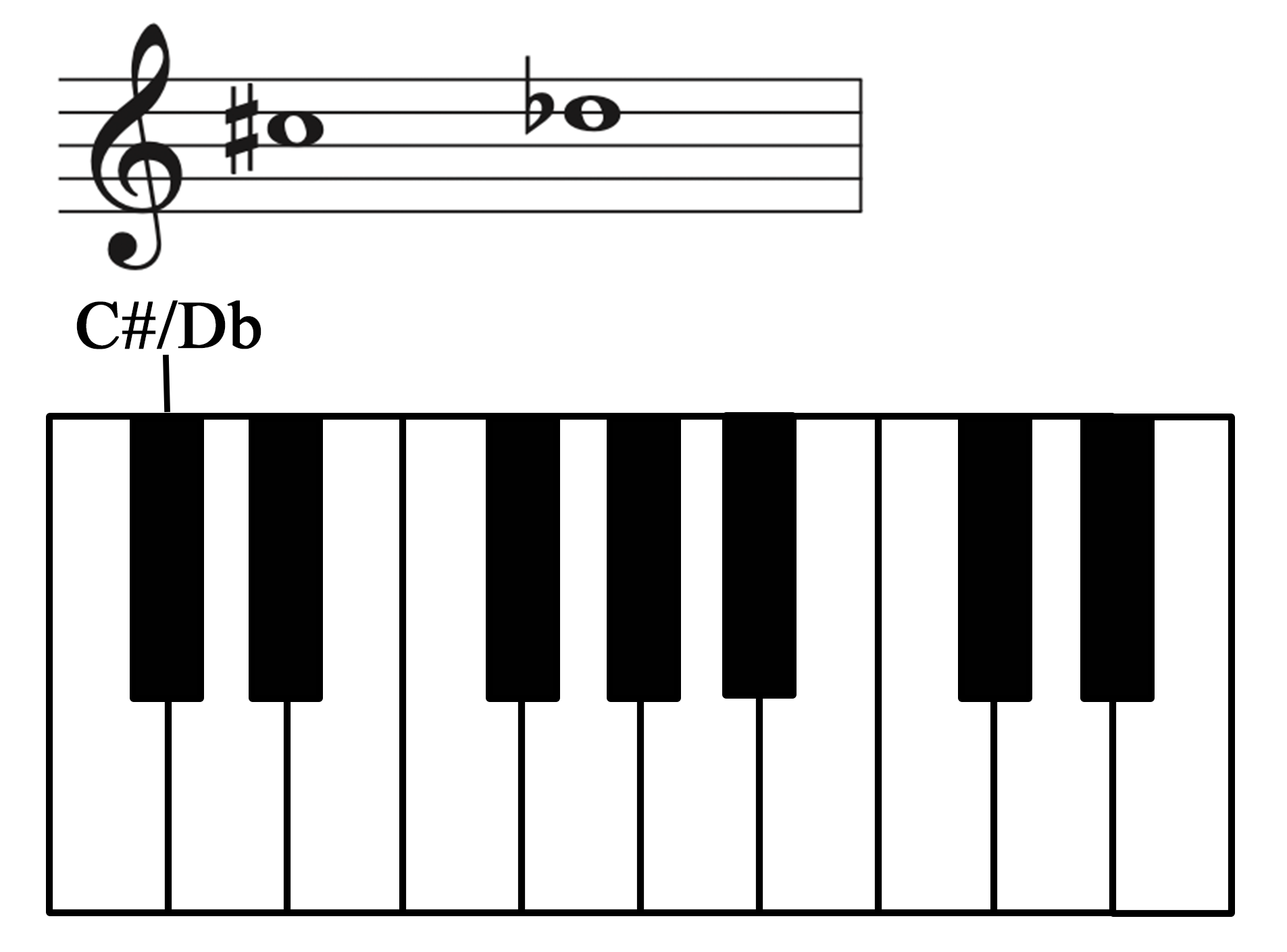
Naming Half Steps and Whole Steps
When naming half steps in music, we can use a diatonic spelling or a chromatic spelling. Notes that are a half step apart and use different letter name are called diatonic half steps. Notes that are a half step apart and use the same letter name are called chromatic half steps.
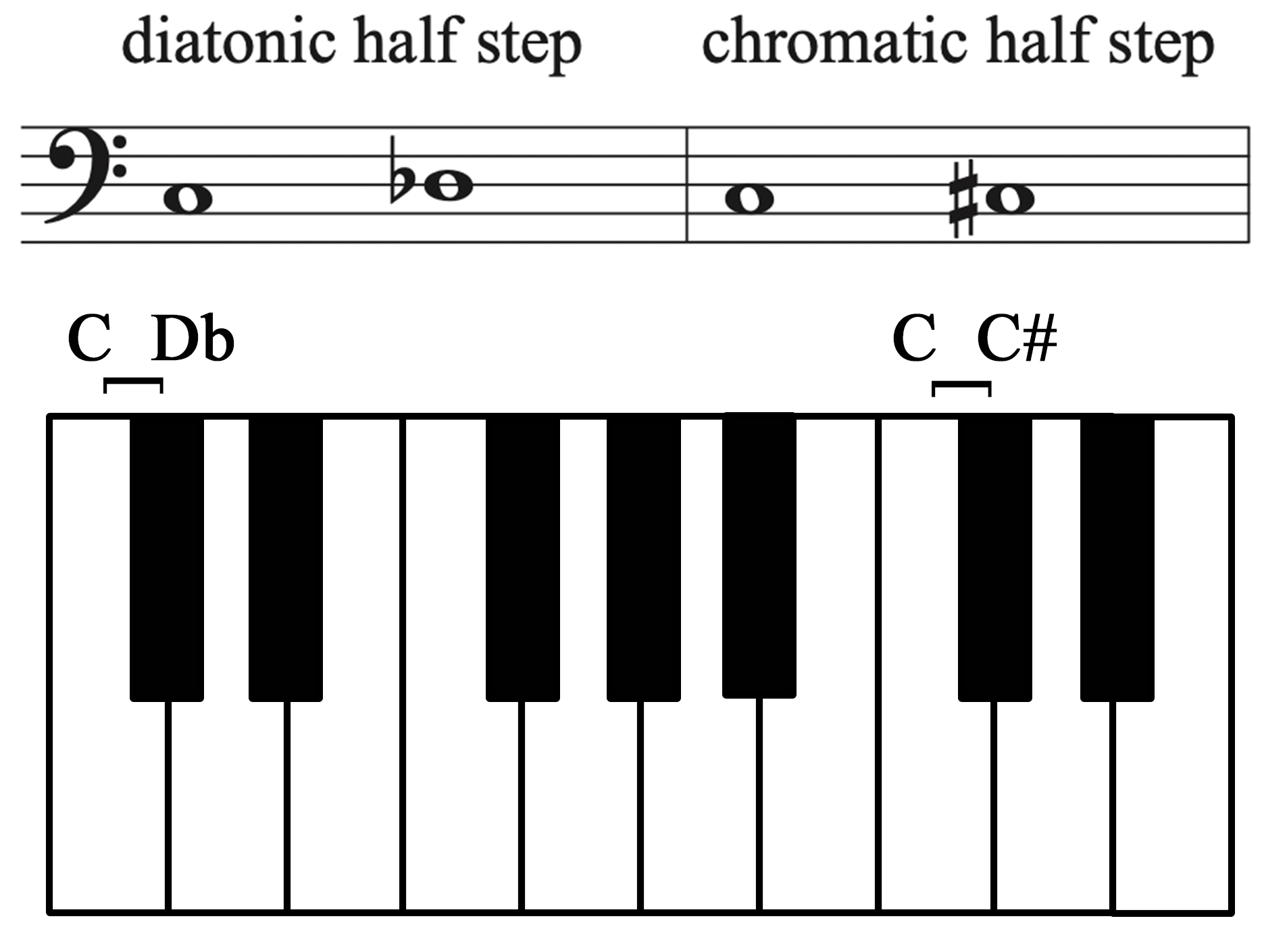
Whole steps are equal to two half steps and a written using letter names that are one letter apart. Most often, a whole step is the distance from white key to white key on the piano or from black key to black key on the piano. The exceptions occur when there is no black key between two white keys. In that case, you count the motion from white key to white key as one half step and then count another half step in order to find a whole step.
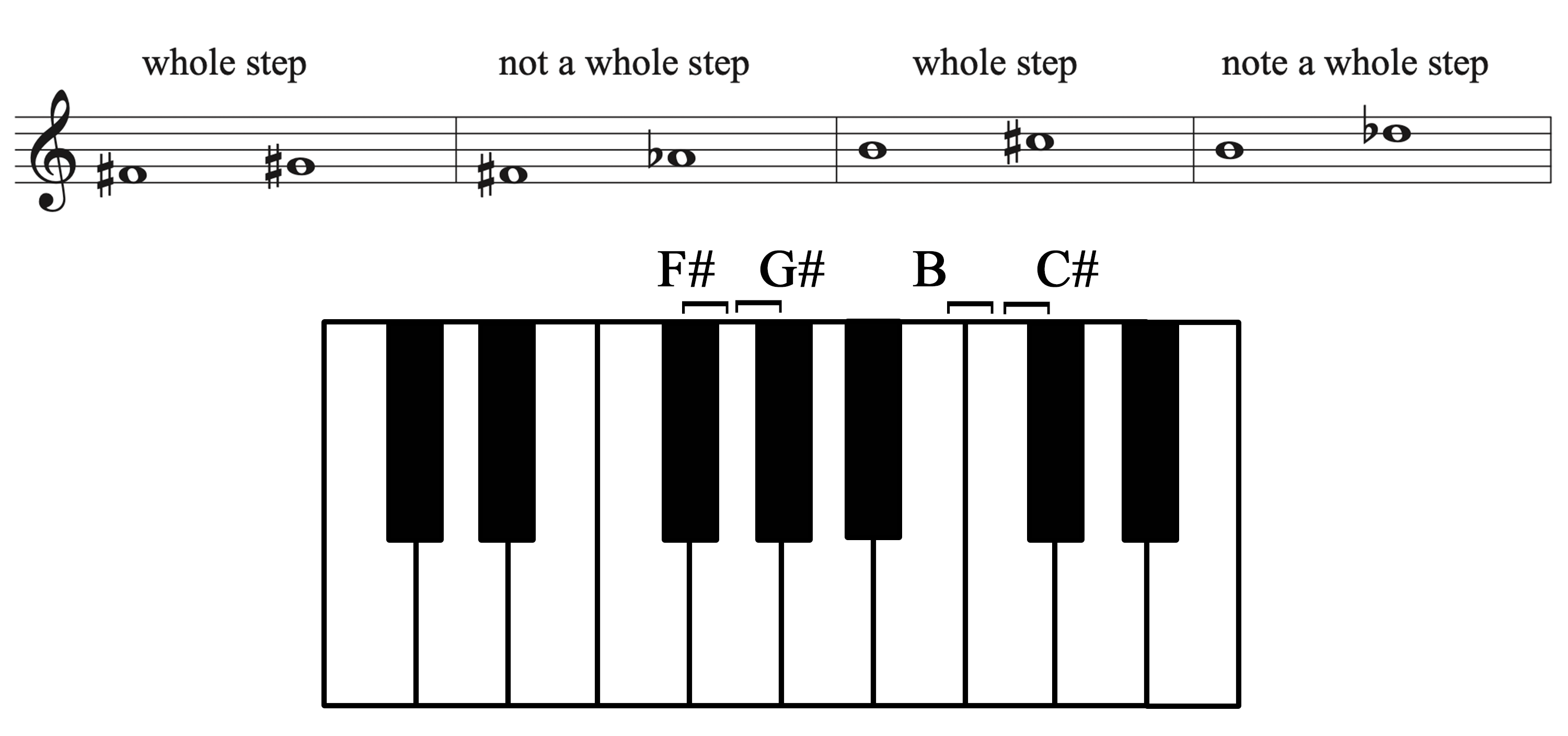
In the example above, F# to G# is a whole step, but F# to Ab is not a whole step, even though the notes are enharmonically equivalent. That is because we spell whole steps with letter names that are a step apart. F to G is a step, but F to A is a 3rd. The same is true for the second example. B to C# is a whole step with letter names a second part. B to Db is a third, not a whole step.
How fluent are you in each clef and at finding pitches on the keyboard? Think about the benefits of becoming fluent. What kinds of things would you be able to do that are currently out of your reach? How would you be able to interact better with other musicians who play different instruments? How would being able to easily read a score change your experience and access to new repertoire? How would fluency in all things relating to pitch help you collaborate better? You can become more fluid at clef reading and can improve keyboard skills by using apps like Staff Wars, which allow you to have fun while also honing your skills and improving your speed.

